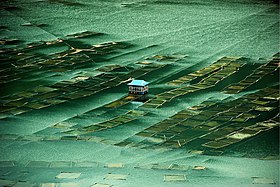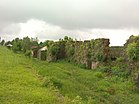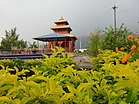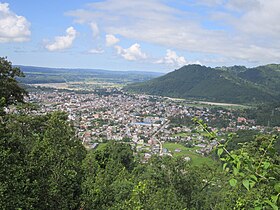Makwanpur District
Makwanpur District
मकवानपुर | |
|---|---|
District | |
|
NPT) | |
| Main Language(s) | Nepali |
| Website | www.ddcmakwanpur.gov.np |
Makwanpur District(
History
During
Geography and climate
| Climate Zone[4] | Elevation Range | % of Area |
|---|---|---|
| Lower Tropical | below 300 meters (1,000 ft) | 7.2% |
| Upper Tropical | 300 to 1,000 meters 1,000 to 3,300 ft. |
59.0% |
| Subtropical | 1,000 to 2,000 meters 3,300 to 6,600 ft. |
28.9% |
| Temperate | 2,000 to 3,000 meters 6,400 to 9,800 ft. |
4.9% |
Demographics
| Census year | Pop. | ±% p.a. | ||
|---|---|---|---|---|
| 1981 | 243,411 | — | ||
| 1991 | 314,599 | +2.60% | ||
| 2001 | 392,604 | +2.24% | ||
| 2011 | 420,477 | +0.69% | ||
| 2021 | 461,053 | +0.93% | ||
| ||||
| Source: Citypopulation[5] | ||||
At the time of the 2011 Nepal census, Makwanpur District had a population of 420,477.
As their first language, 45.8% spoke Tamang, 41.5% Nepali, 4.1% Newari, 3.9% Chepang, 1.4% Magar, 0.9% Bhojpuri, 0.6% Maithili, 0.5% Rai, 0.2% Gurung, 0.2% Lepcha, 0.2% Majhi, 0.1% Hindi, 0.1% Pahari, 0.1% Tharu, 0.1% Urdu and 0.2% other languages.[6]
Ethnicity/caste: 48.3% were Tamang, 14.1% Hill Brahmin, 10.5% Chhetri, 6.2% Newar, 4.6% Chepang/Praja, 4.5% Magar, 2.9% Kami, 1.9% Rai, 0.8% Damai/Dholi, 0.8% Majhi, 0.7% Gurung, 0.4% Musalman, 0.4% Thakuri, 0.3% Danuwar, 0.3% Kathabaniyan, 0.3% Pahari, 0.3% Sanyasi/Dasnami, 0.3% Sarki, 0.2% Gharti/Bhujel, 0.2% Tharu, 0.1% Terai Brahmin, 0.1% other Dalit, 0.1% Ghale, 0.1% Hajam/Thakur, 0.1% Kalwar, 0.1% Kanu, 0.1% Limbu, 0.1% Marwadi, 0.1% Sunuwar, 0.1% Teli, 0.1% other Terai, 0.1% Yadav and 0.2% others.[7]
Religion: 48.3% were Hindu, 45.6% Buddhist, 4.8% Christian, 0.7% Prakriti, 0.4% Muslim and 0.2% others.[8]
Literacy: 67.5% could read and write, 2.7% could only read and 29.8% could neither read nor write.[9]
Administration
The district consists of 10
- Hetauda Sub-Metropolitan City
- Thaha Municipality
- Bhimphedi Rural Municipality
- Makawanpurgadhi Rural Municipality
- Manahari Rural Municipality
- Raksirang Rural Municipality
- Bakaiya Rural Municipality
- Bagmati Rural Municipality
- Kailash Rural Municipality
- Indrasarowar Rural Municipality
Former Village Development Committees and Municipalities
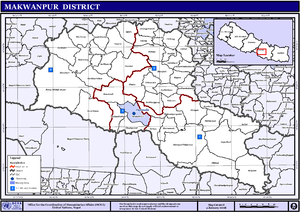
- Agara
- Ambhanjyang
- Bajrabarahi
- Betini
- Bhainse
- Bharta Pundyadevi
- Bhimphedi
- Budhichaur
- Chhatiwan
- Chitlang
- Dandakharka
- Dhimal
- Gogane
- Handikhola
- Hetauda (Sub metropolitan city)
- Hurnamadi
- Ipa Panchakanya
- Kalikatar
- Kankada
- Khairang
- Kogate
- Kulekhani
- Makwanpurgadhi
- Manahari
- Manthali
- Markhu
- Marta Punchedevi
- Namtar
- Nibuwatar
- Fakhel
- Phaparbari
- Raigaun
- Raksirang
- Sarikhet Palase
- Shikharpur
- Sripur Chhatiwan
- Sisneri Mahadevsthan
- Sukaura
- Thaha Municipality
- Thingan
- Tistung Deurali
Notable people
- Tilak Bahadur Negi Lamaतिलक बहादुर नेगी - Nepalese politician, first minister of Makwanpur District and nepalese Tamang people/Communities in June 16 1981 (२०३८ असार २ गते).[11]
- Rupchandra Bista - Nepalese politician
- Kamal Thapa - Nepalese politician
- Ganesh Thapa - ex. president of the All Nepal Football Association
- Para Taekwondo Team Coach and 2020 Summer ParalympicsCoach
- Ananta Prasad Paudel - Nepalese politician
- Ganesh Lal Shrestha - Nepalese poet, musician and social worker
- Bal Krishna Pokharel - Nepalese writer, linguist, historian, and literary critic
- Kedar Ghimire - Nepalese comedian, actor, scriptwriter, and film producer
- Ajeya Sumargi - chairman of the Muktishree group of companies
- Anjan Bista - Nepali footballer
- Bikash Bista - Nepalese Economist and Statistician, and the former Director General of Central Bureau of Statistics of Nepal
- Birodh Khatiwada - Nepalese politician
- Indra Bahdur Baniya - Nepalese politician
- Girija Prasad Adhikari
- Prabesh Rijal
- Dipak Bahadur Singh
- Rajan Mainali
- Shrinkhala Khatiwada - Nepalese model and Miss Nepal World 2018
- Sunil Bal - Nepalese footballer
- Para Taekwondopractitioner
References
- ^ General Bureau of Statistics, Kathmandu, Nepal, Nov. 2012
- ^ "Census Nepal 2021". censusnepal.cbs.gov.np. Retrieved 2024-03-05.
- ^ "population | national_population and housing_census_year results". censusnepal.cbs.gov.np. Retrieved 2024-03-05.
- ^
The Map of Potential Vegetation of Nepal - a forestry/agroecological/biodiversity classification system (PDF), Forest & Landscape Development and Environment Series 2-2005 and CFC-TIS Document Series No.110., 2005, ISBN 87-7903-210-9, retrieved Nov 22, 2013
- ^ "NEPAL: Administrative Division". www.citypopulation.de.
- ^ NepalMap Language [1]
- ^ NepalMap Caste [2]
- ^ NepalMap Religion [3]
- ^ NepalMap Literacy [4]
- ^ "स्थानिय तह" (in Nepali). Ministry of Federal Affairs and General Administration. Archived from the original on 31 August 2018. Retrieved 1 September 2018.
- ^ "सोनाम ल्होछारको अवसरमा तामाङ समुदायका पहिलो मन्त्री सम्मानित".
- "Districts of Nepal". Statoids.

